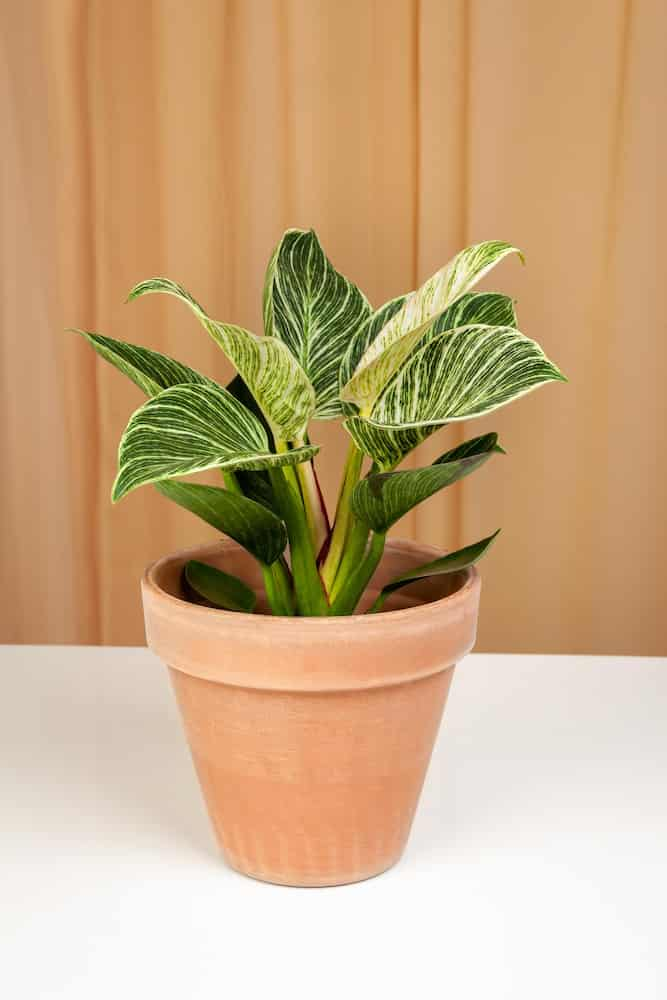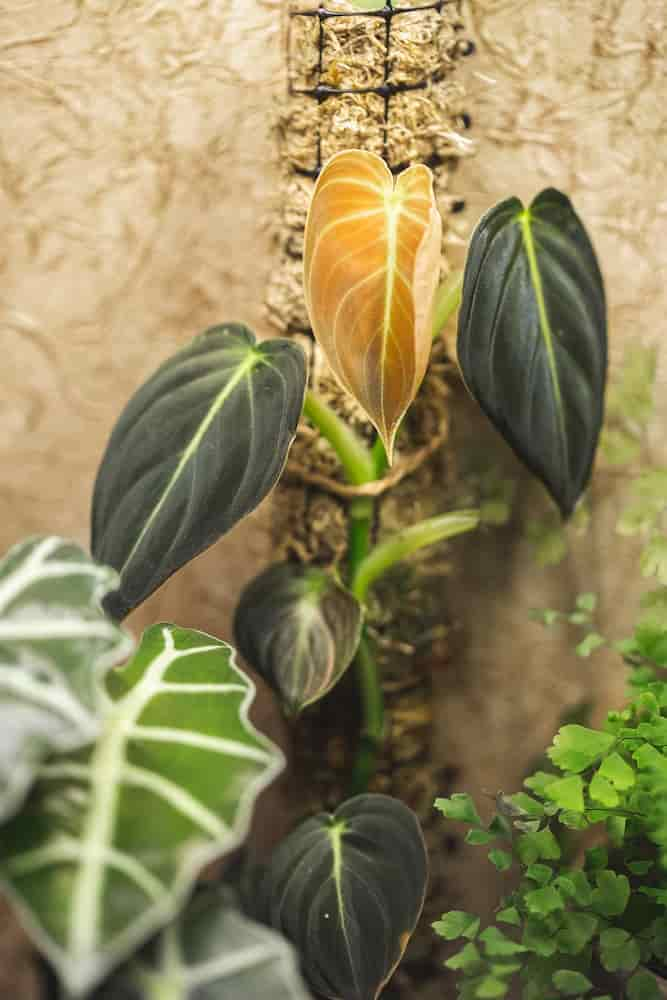Trimming a philodendron not only helps to get rid of dead and damaged foliage, but it makes room for new growth and even helps to maintain the appearance and shape of the plant.
Fortunately, as you’ll see, pruning a philodendron is a simple process that takes only a few minutes. And given how good this is for your plant, you may just find this to be the easiest part of your houseplant maintenance routine.
Keep reading to learn how to properly trim a philodendron.

Table of Contents
How to prune philodendrons
Pruning a philodendron only requires a pair of sharp pruning shears, but does take a little pre planning before snipping off leaves and stems.
1. Step back and look at the philodendron
You should never go into the pruning process without first taking a good long look at the philodendron and assessing the situation. Consider the reason for the trim. Do you want to get rid of damaged leaves or do you want to control the plant’s growth?
This information will help you determine where you should make your cuts, as well as how much to remove from the philodendron.
2. Decide where to make your cuts
The next step is to decide where you will make your cuts. This part should be easy if you completed the first step listed above. Make a mental note of the areas you will be pruning off the philodendron, as well as which areas not to trim.

3. Trim off the unwanted vines
Use a pair of clean and sharp pruning shears to trim off any unwanted vines. Locate where the vine connects to the main stem and snip the vine off with the pruning shears. Try to make the cut as clean as possible.
4. Prune off leaves that are damaged, discolored, or dead
Once all the unwanted vines have been removed, you can move onto pruning the leaves. Look for leaves that are damaged, discolored, or dead and snip them off the vine, making sure to cut just above a leaf node.
You want to keep the leaf node on the philodendron since this is where new growth will emerge.
5. Discard the foliage in the trash
Even if you are sure the plant is not diseased, it is best to err on the side of caution and discard the removed leaves and vines in the trash. Composting leaves and veins from diseased plants can quickly cause the problem to spread.

6. Clean and sanitize the pruning shears
After pruning a philodendron, or any plant for that matter, clean and sanitize the pruning shears before putting them up. This can be done by mixing 9 parts water with 1 part bleach.
Dip the pruning shears in the solution for several seconds after you have washed the shears with warm soapy water.
Make sure to rinse the shears clean with warm water and let them air dry before putting them away.
Best time for trimming a philodendron
The best time to trim your philodendron is during the spring or the fall. With that said, however, it is generally safe to give the plant a light trim any time of the year, as long as you are merely removing a few discolored or old leaves, or are pruning away leggy growth.
For more intense trimming, however, you should wait until the spring or fall as that is when the plant can handle more in depth removal of its leaves. With that said, however, you should never remove more than 1/4 of the plant’s leaves at one time.
Avoid trimming a philodendron during the winter since this is its dormant period. Trimming during this timeframe can stress the plant, and since it isn’t actively growing, it is less likely to tolerate the stress as well.
With that said, however, you can still prune during this time if the pruning is needed for emergency purposes.

Should philodendrons be cut back?
Cutting back on a philodendron plant can actually be beneficial for both you and the plant. This is especially true if the plant has started to become leggy, which means there are more stems and fewer leaves. Cutting back the plant can help promote the growth of leaves and get rid of the long, spindly stems.
Additionally, a leggy philodendron is not nearly as healthy as a bushier plant that has an abundance of foliage. So cutting back the plant can actually help to make it healthier and happier.
If the plant you are pruning is healthy, you can use the pruned stems to make stem cuttings and propagate your philodendron plant. These young plants make great gifts for friends and family members.
Related: 6 Easy Steps to Make Your Philodendron Fuller and Bushier
What happens if you don’t trim your philodendron?
Not trimming your philodendron can cause the plant to become unruly with an untidy appearance. It can also cause the plant’s growth to slow or stop. The most common side effect of not trimming a philodendron is legginess, which is when a plant has more stems than leaves.
The stems instead become long and spindly with few leaves. Not only is this look not very attractive, but without leaves, the plant cannot obtain the proper nutrients from the sun.
This, in turn, may cause your philodendron to stop growing.
Do philodendron leaves grow back?
Philodendron leaves do grow back. In fact, the philodendron plant is considered a fast growing plant, and it can grow leaves pretty quickly during the plant’s growing season, which is in the spring and summer. This is why trimming a philodendron can actually make it ultimately look fuller.
While the philodendron is growing its vining stems, it will also start to produce leaves and even aerial roots. This can cause the plant to become out of control, especially when grown in a small spice. This is when trimming the plant can come in handy.
Trimming a philodendron will help to control the overall size and shape of the plant. When your philodendron is starting to grow too much too quickly, get out the pruning shears and start cutting the plant back a little.
Can you cut the trunk of a philodendron?
You shouldn’t cut the trunk of a philodendron. Unlike some other plants, the philodendron won’t produce new branches or stalks when the trunk is cut. What it can do, however, is cause the plant to start to decline, wilt, and even die.
Cutting the philodendron’s trunk also increases the chance of disease infecting the plant, and does nothing to improve its health. There is no reason to cut the trunk of a philodendron unless you are trying to kill the plant.
You can, however, trim a philodendron’s leaves and vines to help maintain a more manageable size. It will also promote healthy growth and can make a leggy philodendron have a bushier appearance.

Where do you cut a philodendron for new growth?
Where to cut the philodendron for new growth will depend on what you are pruning off the plant. For example, when cutting leaves off the philodendron, trim right above a leaf node. The leaf node is where new growth will sprout.
However, if you are removing leaves, you won’t be cutting the plant in the same place as if you were removing vines.
When cutting vines, make the snips at the intersection where the vine meets the main stem, making sure not to cut the main stalk.
Related: What is a Philodendron’s Growth Rate (+ How To Grow It Faster)?
How do you trim an overgrown philodendron?
Trimming a philodendron is a simple process that only requires making cuts with a pair of pruning shears. Where you make the cuts, however, will depend on what you are removing from the philodendron. If you are removing the stem, cut the stem or vine close to where it meets the main stalk.
When pruning away leaves, you simply want to make the cut above a leaf node. No matter what part you are removing, however, discard the pruned portion of the philodendron in the trash.
How to prune a large philodendron
Pruning a philodendron is done in about the same manner no matter what the size of the plant. This means assessing the situation before even picking up a pair of pruning shears. Take a good look at the philodendron and decide where you will make your cuts.
Use a pair of sharp pruning shears and start to cut away any unwanted vines or stems. Clip the vines off by cutting them off where the vine meets the main stem. Move onto the leaves, clipping off the unwanted leaves right above a leaf node.

How to prune a philodendron for propagation
Philodendrons are one of the easiest houseplants to use for propagation, and they are probated via stem cuttings. To begin, locate a stem that is several inches long, about 4 to 6 inches, and has at least 3 to 4 leaves on it. Cut the stem above a leaf node and then remove the bottom leaves.
Dip the cut end of the stem in rooting hormone and either plant the stem, cut side down, in soil or place it in a glass jar filled with water. If using soil to propagate your philodendron, keep the soil moist but not soggy and set the cutting in an area where it will receive bright, indirect light.
Related: Philodendron Light Needs: The Ultimate Guide
If you are rooting a philodendron cutting in water, set the glass container somewhere where it won’t be disturbed but will receive bright, indirect sunlight. Change the water once every 7 to 10 days or when the water starts to become cloudy.
Should I fertilize the philodendron after pruning?
After you have pruned the philodendron, you may want to apply a little fertilizer to help encourage the plant to grow new leaves and vines. Use a balanced fertilizer in liquid form and apply it at half strength. For example, if the directions recommend 1 teaspoon, use only half a teaspoon.
Keep in mind, however, that you shouldn’t apply fertilizer to your philodendron if you have recently fed the philodendron.
A good general rule of thumb is to not add fertilizer after pruning if it has been less than a month since the last time you did so.
